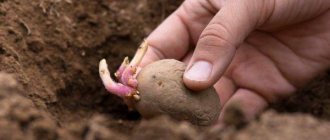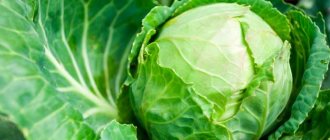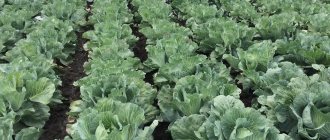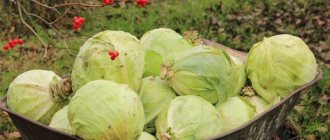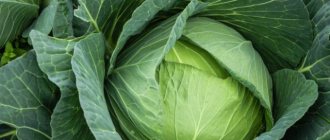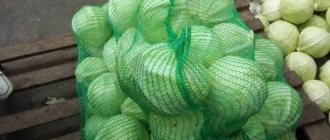Vegetable growing » Cabbage
0
1153
Article rating
Kira Stoletova
Bronco cabbage f1 is a hybrid of mid-season white cabbage bred in the Netherlands. Currently, hybrid seeds are in demand both in mass agricultural production and in home cultivation.
Characteristics of cabbage variety Bronco f1
History of selection of the Bronco variety
Bronco F1 is a classic representative of mid-season cabbage varieties. This hybrid is characterized by attractive, firm heads weighing from 2 to 4 kg with a small diameter. It is presented by the Dutch company BEJO ZADEN BV. Suitable for cultivation in the Central regions of Russia (4th winter hardiness zone). The date of inclusion of the variety in the State Register is 1997.
Did you know? The origins of white cabbage are unknown. Its wild relatives in the cruciferous family grow throughout the world. But there is no sufficient reason to assume that this or that plant
—
her direct ancestor.
Description and characteristics
White cabbage belongs to the cruciferous family. It is a herbaceous plant with a straight and barely branched stem on which the leaves are located. In most cases they have a round shape with slightly beveled edges. The head is formed as a result of the development of the core and the fact that the upper leaves are compressed relative to it. The cabbage development cycle lasts 2 years. In the first year the head is formed. In the second year, a stem is formed that flowers and produces seeds.
The Bronco variety can be considered the standard for white cabbage. It is considered universal, for which it is valued in traditional cooking in many countries. Cabbage is prepared in various ways: stewed, fried, canned, but it is also good in the form of fresh salads.
Cabbage is recommended in a low-calorie diet, as it is rich in fiber and contains few calories. In addition, it is an important source of vitamins and minerals, as well as other biologically active substances. Bronco is characterized by:
| Leaf rosette | semi-raised |
| Head | round shape, compact, dense, light green |
| Leaves | medium size, round, dark green, waxy |
| Weight | 2–4 kg |
| Diameter | 15–17 cm |
| Texture | dense, crispy |
| Taste | sweetish |
| Sustainability | the variety is resistant to fusarium, tolerant of black rot and fire blight |
| Ripening period | 79 days |
Productivity and fruiting
When planting cabbage, a farmer always expects high yields. For Bronco it is 5–8 kg/m² of area. By 60–65 days of growth, one head of cabbage weighs at least 2 kg. To increase productivity, you need to provide the plant with excellent watering and timely fertilizing.
Ripening time
Bronco is a mid-season variety. Its heads of cabbage fully ripen at 75–79 days, reaching their maximum weight. But you can cut off the heads for direct consumption as early as 60 days.
Resistance to diseases and pests
The originator declared the variety's resistance to fusarium and relative tolerance to black rot and fire blight. Cabbage tolerates drought and adverse weather conditions well. Also, its heads of cabbage are resistant to cracking.
Did you know? The ancient Greeks knew several varieties of cabbage. They are mentioned in the treatises of Theofast. But it is not known whether they are related to modern types of cabbage or whether they were other cruciferous vegetables.
Reviews from summer residents
Ekaterina Yurievna, Kyiv, 43 years old.
I have been growing the Bronco variety for several years now. Mid-season hybrid. The head of cabbage is white in cross section, the structure is quite dense. Among the main advantages, I can note good immunity, I have never encountered diseases during cultivation, as well as the fairly good taste of the heads of cabbage. There are no disadvantages as such, but you will have to tinker with parasites. Our caterpillars often attack Bronco, although late varieties grow nearby, which they do not touch so readily.
Vladimir Viktorovich, Voronezh, 51 years old.
Bronco's heads of cabbage are relatively small, but very dense. The heads are stored for a long time, although this is not a late variety. The taste is excellent; in salads, cabbage melts in your mouth. There are no strong veins, and this is a huge plus. Once upon a time they grew a variety, I don’t remember the name, it was all veins. Nothing about cabbage. Bronco, on the contrary, has very soft and delicate leaves.
Pros and cons of the variety
- Advantages of the variety:
- excellent presentation of heads of cabbage;
- good taste;
- high productivity;
- unpretentiousness;
- amicable maturation;
- possibility of cultivation in the northern regions.
- Disadvantages of the variety:
- short shelf life - 2-3 months;
- There is no data on the variety’s resistance to pests, so all preventive measures must be carried out.
Rules for growing the variety
Cabbage needs a sunny area and dense soil. To do this, in the fall, rotted manure is applied to the selected area and left for the winter to compact the soil. Before planting, make sure that the heads of cabbage will stand firmly in the soil.
Important! You cannot grow cabbage in the area where it grew last year.
In addition to open ground, it is possible to grow cabbages in containers or greenhouses. Sowing can be done with seeds or seedlings. The second method is convenient because it allows you to get a harvest in the ground earlier than if you sow seeds. In addition, you will even have time to grow lettuce in this area before cabbage.
Preparation of planting material
A good harvest depends on many factors, including proper planting of the vegetable. Pre-planting preparation consists of preparing the seeds and preparing the site itself. After removing the seeds from the bag, soak them in a 3% solution of ordinary salt. Action time: 5 minutes. This process is called calibration.
All “empty” seeds will float, and those that settle to the bottom can be planted. It is believed that the larger the seed, the greater its development potential. Therefore, small seeds are discarded if possible.
Soaking at a temperature of +50°C disinfects them from fungal spores. The same effect can be achieved by soaking in a slightly pink solution of potassium permanganate for 20–30 minutes. Germinated seeds germinate faster and more efficiently.
To do this, they are placed on a saucer under a piece of damp gauze or napkin. The room temperature should be normal - about +20°C. After 3 days they will be ready for planting, but you can wait a few more days if they do not germinate well enough.
Growing seedlings
Growing seedlings begins with preparing the soil. You will need turf soil and humus, taken in equal quantities. As a potassium fertilizer, add ash - 1 tbsp. spoon per 1 kg of soil mixture.
Plan to plant cabbage seedlings 4 weeks before you plan to plant it in the ground. Seeds are sown in prepared containers to a depth of 0.5 cm. If planting occurs in boxes, then at a distance of 2 cm from each other. If in cups, then 1-2 seeds in each cup.
Then, you can leave the plant that will be better developed. The approximate time for planting seedlings is March. The seedlings should be kept under bright light. The soil must be constantly moist. Seedlings are planted if they have 3 true leaves and the outside temperature has reached +10°C.
Did you know? The largest head of cabbage was grown by Scott Robb. She was presented at an exhibition in Palmer (USA) in August 2012 and weighed 62.71 kg.
Preparing the site and soil
The soil is dug up in the fall in order to remove weeds, loosen it well and add lime to deoxidize it if the acidity level is above 6–6.5 pH. During spring digging, fertilizers are applied. This could be rotted manure or humus.
Before fertilizing, the soil is disinfected with a hot solution of copper sulfate 1% (1 tablespoon per 10 liters of water). The variety is almost not sensitive to drought, but needs sunlight. Therefore, the site should be located so that it is illuminated for at least 4 hours a day.
Transplanting seedlings into the ground
Cabbage is planted in the ground if it has 3–5 true leaves and the outside temperature is not lower than +10°C. Landing is carried out in sunny, windless weather. The day before transplanting, the seedlings need to be watered well.
If the plants grew in soluble cups (peat, cardboard), then the seedlings are planted without removing them from them. It is necessary that the distance between individual plants be at least 40 cm. If the cup is plastic, then remove the seedlings carefully so as not to damage the roots. Plant at the same depth as it grew in cups. The distance between rows of plants can be from 50 to 70 cm.
Planting technology:
- prepare the soil;
- make a trench about 5 cm deep;
- Water thoroughly;
- place the cabbage seedlings in the trench about 30 cm apart;
- compact the soil around the seedlings and fill the trench;
- Water carefully again.
Important! Best time to plant
—
early morning or late afternoon. This way the seedlings do not come into contact with the hot sun. Always water your cabbage well before and after planting.
Boarding order
The Bronco variety is grown by seedlings. Seedlings require certain care, which consists of maintaining the required temperature and watering. When the cabbage grows, it is transferred to open areas.
Preparing seeds and soil
Planting seeds of the Bronco variety occurs at home. Work is carried out in late April - early May. The formation of seedlings takes 45-50 days.
For planting, prepare soil consisting of equal amounts of turf soil and humus. Add a tablespoon of wood ash per kilogram of soil. To increase soil fertility, you can add a little peat. Prepare the soil yourself or purchase a ready-made soil mixture.
Seeds of the Bronco variety also require processing. They are placed in hot water at a temperature of 50 degrees for 20 minutes, after which they are transferred to cold water for 5 minutes. The drug Epin or Humate will help stimulate the germination of cabbage. The seeds are placed in a solution based on it for several hours.
Some manufacturers produce already processed seeds. They are usually painted in bright colors. These seeds do not require soaking and can be planted directly into the ground.
Obtaining seedlings
The soil is poured into boxes 12 cm high. In this case, the grown cabbage seedlings will have to be picked by transplanting into separate containers. Furrows are made in the soil to a depth of 1 cm. Seeds are planted every 2 cm. Leave 3 cm between rows.
To avoid replanting, you can take 10 cm high cups and plant 2-3 cabbage seeds in them. When the Bronco variety cabbage shoots appear, choose the strongest one and weed the rest.
The first shoots will appear on the 4-5th day. Before the first leaf forms, the cabbage is kept for a week at a temperature of 6-10 degrees.
When leaves begin to form, the ambient temperature is increased to 16 degrees. At night its value should be 10 degrees.
Cabbage seedlings are provided with lighting for 12 hours and fresh air without drafts
Water the plants periodically; it is important not to let the soil dry out.
If Bronko cabbage is grown in boxes, then two weeks after the sprouts appear, the mature seedlings are plucked. The seedlings, together with a lump of earth, are transferred to a glass filled with peat and humus.
Transplantation into open ground
Before planting Bronko cabbage in the ground, harden it. First, you can open the window for 3 hours, then the seedlings are transferred to the balcony. A week before planting, cabbage should be constantly in the fresh air.
Planting work is carried out when the plant has 4 leaves and the height reaches 15 cm. The Bronco variety can be planted in the ground from the end of May.
Bronco cabbage prefers clay soil or loam. The area should be illuminated by the sun throughout the day.
Cabbage should not be grown in beds that contained radishes, radishes, mustard, turnips, rutabaga or any variety of cabbage the year before. Good predecessors are grasses, clover, peas, carrots, and legumes.
In the spring, the bed is leveled with a rake, after which holes are prepared for planting. Seedlings of the Bronco variety are placed in increments of 40 cm. A handful of peat, sand and wood ash can be added to each hole.
The plants are transferred together with a lump of earth and the root system is sprinkled with soil. The last stage is abundant watering of the beds.
Plant care
After planting, cabbage needs watering, periodic feeding, pest control and weed removal. Removing weeds leaves more nutrients for the seedlings and improves their growth.
Watering and fertilizing
Cabbage constantly needs moist soil. It should not be swampy or have standing water at the roots, but weekly watering is required. If the soil dries out to a depth of 7–9 cm within a week, water more often. Morning watering is preferable to evening watering.
The approximate rate of liquid consumption is 10 liters per 1 m² of area. To maintain a constant level of soil moisture, add up to 10 cm of mulch around the cabbage. Mulch slows down the evaporation of moisture and prevents overheating if the weather is hot.
The best materials for cabbage are spunbond or agrofibre. They cover the soil before planting, and the seedlings are planted in cuts on the material.
Cabbage consumes a lot of nutrients. You will need to fertilize every 2 weeks. The best option is a balanced composition of nitrogen, phosphorus and potassium in a ratio of 10-10-10.
The numbers indicate that the share of each of the listed substances in the fertilizer is 10%. The soil must be well watered before and after fertilizing.
Loosening and weeding
Loosening is carried out as needed after each watering. If the area is covered with mulch, then this is not necessary. Mulch prevents weed growth and keeps the soil moist and loose. If cabbage simply grows in beds, then the depth of tillage is 4–8 cm.
Loosening is carried out after watering, combining with weed removal. You can loosen with a garden hoe, electric or mechanical cultivator. If the weather is rainy, loosen the soil after it dries slightly.
Did you know? In ancient China (circa 1000 BC), cabbage was believed to help with baldness. She was the main one of the special elixir. It is unknown whether the remedy helped the ancient Chinese, but this vegetable does contain many beneficial nutrients.
Landing
To grow seedlings, purchase a store-bought substrate (specialized or universal)
An important condition for the soil mixture is the pH level in the range of 5.5-7 (neutral)
Seeds can be sown in self-prepared soil. To do this, mix the following components
- like sod from a garden
- non-acidic high peat
- compost
- humus.
The ingredients are taken in a ratio of 1 to 1. For greater looseness, add vermiculite and sand. Choose containers that are wide, with a side height of at least 7-8 cm. Seeds are sown:
- to a depth of 1 cm;
- in increments of 5 cm;
- in a checkerboard pattern.
For planting, you can use peat tablets and cups.
Sowing time is from the end of March to the first half of April.
Pest and disease control
If there are a lot of butterflies in the garden, then the cabbage definitely needs protection. Some farmers advise covering cabbage crops with netting to prevent butterflies from landing on the leaves and laying eggs. Another cabbage pest is slugs. Sprinkle the rows with crushed shells, eggshells, or other hard, splintered material. Slugs will not be able to crawl along it to the cabbage.
If there are poultry on the farm, they can be effective against pests. Farmers also practice manual collection of caterpillars if they are found on plants. This is possible if there are a dozen heads of cabbage growing on the plot.
The leg of the head of cabbage of the Bronco variety is of medium length. Therefore, farmers carry out 1-2 hillings per season. Hill up the plant to the point of formation of a leaf rosette. It is believed that the procedure helps fight cabbage fly, as well as some fungal diseases. For example, a black leg.
The first hilling is carried out 14 days after planting the seedlings, and the second - a month after the first.
Important! Hilling is mandatory for large heads. It helps maintain weight.
A delicacy for real gourmets - broccoli Marathon f1: full description
Broccoli Marathon f1 is a tasty and healthy vegetable, known as part of the diet menu. It is eaten to lose excess weight, rejuvenate the body, improve the functioning of the gastrointestinal tract and circulatory system, and improve immunity. The taste of broccoli is specific, but very pleasant.
| Landing location | Ripening time | View | Purpose | Origin | Maturation period | Weight |
| Greenhouse, Open ground | Mid-early | Broccoli (asparagus) | Fresh, Diet food, Cooking | Hybrid | 80-85 | 0,8-1 |
Description and characteristics of the variety
The hybrid broccoli cabbage Marathon f1 is unpretentious and can be grown in a greenhouse or in open ground. Prefers loamy soils and is resistant to cold and major diseases.
The harvest ripens 80-85 days after germination. Description of the plant: the heads are elliptical in shape, dark green, sometimes with a bluish tint. Consist of small buds-beads. Average weight – from 800 g to 1 kg.
Broccoli can be eaten fresh or added to dishes, including dietary ones. The pulp contains folic acid, choline, sulforaphane, methionine, as well as trace elements: potassium, phosphorus, calcium, chromium, magnesium. Of the vitamins, the variety is rich in vitamins E and C.
Advantages and disadvantages
- great taste;
- good yield;
- healing effects on the body;
- cold resistance;
- resistance to major diseases.
Minuses:
From 1 sq. m get 3-4 kg of cabbage.
Landing
Seedlings are sown at the end of March - beginning of April in the middle zone. They are transplanted to a permanent place at the end of April or beginning of May, when stable warmth sets in.
If the seeds were sold in a colored shell, they are not pickled. Untreated grains are pickled for an hour in a 1% potassium permanganate solution. Then they are rinsed and dried.
Sow in nutritious loose soil at a shallow depth. With the emergence of seedlings, they are placed in a cool place with a temperature of +15-17 degrees. Bushes with 4-5 true leaves are planted in the ground according to a 30 by 50 cm pattern.
Growing and care
The soil is regularly loosened to improve oxygen access and cultivation. In the first weeks, water once every 3-4 days, and when the cabbage grows, once a week. On the second day after watering, weeds are removed.
The first feeding is carried out 2 weeks after transplantation. Prepare a solution from 15 liters of water, 0.5 liters of mullein and 1 tsp. urea. After three weeks, feed with a solution of nitrate. During the formation of the heads, they are fertilized with potassium and phosphorus (special complexes for cabbage are suitable).
Possible diseases and pests
If agricultural practices are followed, the hybrid does not get sick. For protection, it is necessary to observe crop rotation: plant cabbage after pumpkin, legumes and nightshade crops and not grow it for two years in a row in one place, water it moderately, and disinfect the soil before sowing.
Of the parasites, the most dangerous are caterpillars, which can destroy standing crops. To protect the cabbage, it is covered with non-woven material, and while there are no heads yet, it is treated with insecticides.
Spray with infusion of garlic or onion against aphids.
Features of harvesting and storage
As soon as the cabbage heads are compacted, they are ready for harvesting. You should not overexpose them in the garden - this can lead to cracking due to high moisture consumption. The heads are cut off at the base with a sharp knife and stored in a shaded area.
In cellar conditions, cabbage will be stored for up to 3 months. After harvesting, be sure to remove all stems and root systems from the soil to prevent the buildup of fungal spores and other pathogens. The temperature in the storage room should be about 0°C and the humidity should be about 90%.
Growing cabbage may seem like a labor-intensive process, but if you do not forget to carry out basic agricultural activities on time, you can get a good harvest.
Oracle F1 cabbage seeds extra early 52-55 days 1.2-1.7 kg av. (Clause)
Order by phone
- +38 ( 050 ) 699-12-64
- +38 ( 066 ) 827-50-68
- +38 ( 066 ) 827-50-68
- +38 ( 067 ) 771-68-61
- +38 ( 068 ) 347-43-44
- +38 ( 097 ) 058-95-54
- +38 ( 093 ) 348-47-82
- +38 ( 063 ) 238-93-97
Important
No minimum order amount! But prepayments are required:
- for orders up to 200 UAH;
- for goods to order - 100% prepayment;
- Each order contains a gift.
Every day:
- Nova Poshta
- Ukrposhta
- Autolux
For order values over 2,500 UAH and weight up to 500 grams, delivery is free (from 12/15/2018)
When ordering for 3,000 UAH - 3% discount, 5,000 UAH - 5% discount, 10,000 - 10% discount
Discounts cannot be combined!
Receive gifts by ordering online
Each customer who places an order online (by registering in the store and making purchases through the basket) receives as a gift a Seed Supermarket magazine, a package of seeds and a calendar (included in the order from September to January).
Contacts for placing an order in the ATO zone
We accept orders for vegetable seeds from the ATO zone
Telephone: 066 061 04 03
White cabbage Oracle F1 - description:
Oracle F1 is an early hybrid of white cabbage (it lasts about two months (52-57 days) until the end of the growing season), which is grown under agrofibre, film covers and in open ground to obtain early production.
In the photo above you can see what cabbage fruits look like: they are uniform, dense, compact, round in shape, light green in color, weighing about 1.5 kilograms. The heads ripen together. The leaves have a nice ball of waxy coating and the root system is very well developed.
This hybrid is used for fresh sale and fermentation; it can also be stored for a long time and transported over long distances.
Oracle F1 is resistant to cracking, like many other hybrids, and fusarium.
What the original packaging looks like:
Attention! The manufacturer reserves the right to change the packaging design, color and availability of seed treatment
